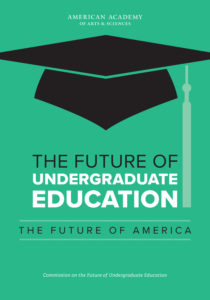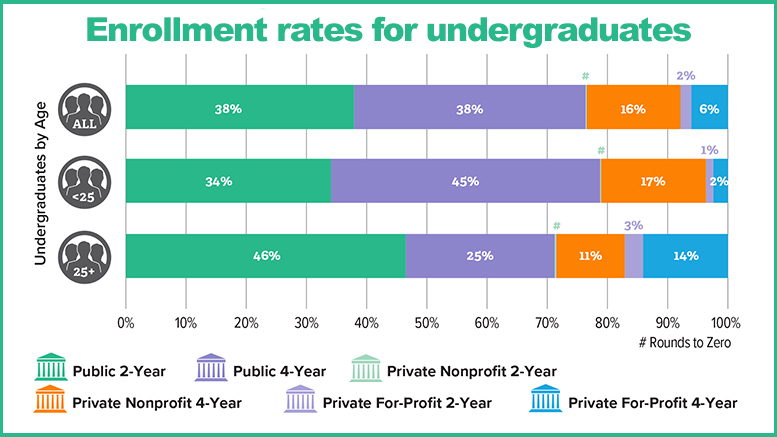The nation’s system of higher education can be significantly improved to ensure more Americans obtain a quality undergraduate education and a meaningful degree without taking on onerous debt, concludes a far-reaching study by the Commission on the Future of Undergraduate Education.
The commission was convened by the American Academy of Arts & Sciences to assess the state of undergraduate education and make recommendations for improvements. Members of the commission include leaders from higher education, business and government.
Noting that only 60 percent of Americans earn a bachelor’s degree over six years and less than 30 percent attain a certificate or associate degree within three years, the commission found “more students are borrowing more while not enough attention is being paid to the quality and value of the education itself.”
“As a result,” the commission states, “too many Americans will not realize the full benefits of college, which include greater civic engagement and improved personal and family well-being, in addition to better economic circumstances.”
Three key goals
The recommendations in “The Future of Undergraduate Education, The Future of America” are focused on three key goals: ensure all students have high-quality educational experiences; increase overall completion rates and reduce inequities among student populations; and manage college costs and make higher education more affordable.
“These very practical recommendations build on the strengths of our students and schools and on a shared vision for the future of our country,” said commission member Gail Mellow, president of LaGuardia Community College in New York. “To support both economic opportunity and a strong democracy, we must invest in higher education as it’s an effective and proven way to boost both.”
Among the recommendations most relevant to community colleges, the report calls for all college graduates, regardless of their major or credential, to have an education that combines academic knowledge and practical skills.
In addition to teaching specific skills needed for a job, for example, a career-focused program in manufacturing should also ensure students understand “how their work fits into the broader manufacturing sector and how to adapt quickly to industrial and technology changes.”
Noting that the growth in part-time, non-tenured faculty positions has been particularly prevalent in open-admissions institutions – those positions make up more than 80 percent of faculty positions at community colleges – the report says those instructors should have more stable professional working environments. It says more of those positions should be full-time with longer-term contracts and a clear voice in governance.
Completion is the top priority
 The report recommends that college and university leaders, with full engagement of faculty and staff, make college completion a top institutional priority.
The report recommends that college and university leaders, with full engagement of faculty and staff, make college completion a top institutional priority.
Improving completion rates requires better data collection and analysis, it says, along with an opportunity for students to have meaningful, personalized connections with staff; more focused attention on groups with the lowest completion rates; expanded experimentation with guided pathways; improved transfer processes; and partnerships with employers.
More attention also needs to be directed toward students who enter college academically unprepared, the report says, as students who need remediation are less likely to earn a credential. Only 28 percent of community college students who take a developmental course earn a degree within eight years, the report notes.
College readiness should be based on real evidence of factors that contribute to college learning, and colleges should not rely on a single high-stakes placement test, the report recommends. It lauds Long Beach Community College in California for increasing placement and pass rates in college-level English and math by including students’ high school GPAs in placement decisions.
In another example, the report cites the Accelerated Learning Program, a co-requisite model, at the Community College of Baltimore County for improving students’ pass rates in college-level English.
Student aid improvements needed
The commission urges the federal government to provide strong incentives for states to more generously fund public institutions and urges funding formulas to recognize that community colleges and regional comprehensive universities disproportionately educate first-generation college students and students from disadvantaged backgrounds. (The House Education and the Workforce Committee is expected to release by week’s end its bill to reauthorize the Higher Education Act (HEA); the Senate aims to take up its HEA bill in early 2018.)
Scarce resources should go to students for whom they will have the greatest impact, the report says.
To address college affordability, the report recommends the following:
- Ensure students understand the potential earnings and debt levels associated with various college credentials and career paths.
- Simplify or even eliminate the FAFSA (Free Application for Federal Student Aid) and rely more on financial information already available from the Internal Revenue Service.
- Allow students to use Pell grants for completing 30 credits anytime throughout the course of a calendar year.
- Develop guidelines for colleges whose students are unable to repay their federal loans to reimburse the government a fraction of the unpaid balance.
- Revise eligibility so federal financial aid can’t be use at low-performing institutions with extremely low graduation rates.
Fitting in a new world
The report considers how higher education can adapt to a distant future where there is likely to be less social cohesion; a workforce that relies more on advanced robotics, artificial intelligence and virtual reality; less privacy due to “big data”; and “unforeseen human-generated global challenges.”
When machines take on more of the work, it says colleges need to “double down on teaching the skills that are most difficult for machines to replicate, such as solving unstructured problems, working flexibly with new information, and working effectively in groups.”
And in an increasingly fractured nation, colleges can play a role in providing more opportunities for meaningful interaction.
The report notes that “colleges and universities are among the few American institutions in which significant numbers of people from different backgrounds and communities come together for a shared purpose.”

